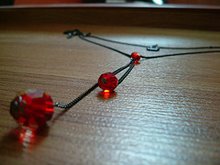









Gold is the most malleable and ductile metal; a single gram can be beaten into a sheet of one square meter, or an ounce into 300 square feet. Gold readily forms alloys with many other metals. These alloys can be produced to increase the hardness or to create exotic colors. Adding copper yields a redder metal, iron blue, aluminium purple, platinum white, and natural bismuth and silver alloys produce black. Native gold contains usually eight to ten percent silver, but often much more — alloys with a silver content over 20% are called electrum. As the amount of silver increases, the color becomes whiter and the specific gravity becomes lower.
Gold is a good conductor of heat and electricity, and is not affected by air and most reagents. Heat, moisture, oxygen, and most corrosive agents have very little chemical effect on gold, making it well-suited for use in coins and jewelry; conversely, halogens will chemically alter gold, and aqua regia dissolves it by virtue of the elemental chlorine generated by this acid mixture.
Common oxidation states of gold include +1 (gold(I) or aurous compounds) and +3 (gold(III) or auric compounds). Gold ions in solution are readily reduced and precipitated out as gold metal by adding any other metal as the reducing agent. The added metal is oxidized and dissolves allowing the gold to be displaced from solution and be recovered as a solid precipitate.
Recent research undertaken by Sir Frank Reith of the Australian National University shows that microbes play an important role in forming gold deposits, transporting and precipitating gold to form grains and nuggets that collect in alluvial deposits.[1]
High quality pure metallic gold is tasteless, in keeping with its resistance to corrosion (it is metal ions which confer taste to metals).[2] Gold is non-toxic if consumed, and is used as food decoration in the form of gold leaf.
In addition, gold is very dense, a cubic meter weighing 19300 kg. By comparison, the density of lead is 11340 kg/m3, and the densest element, Iridium, is 22650 kg/m3.
Ref. Wikipedia



No comments:
Post a Comment